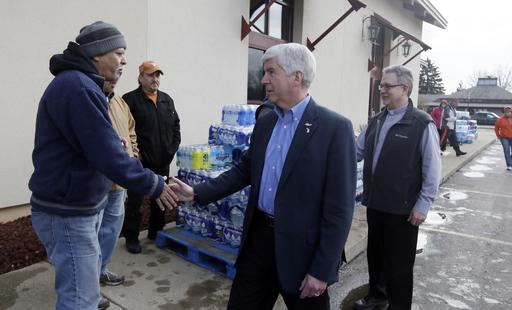
Michigan Gov. Rick Snyder on Wednesday proposed spending hundreds of millions more dollars to address Flint’s water crisis from lead contamination and to update pipes there and across the state — a plan that lawmakers from both parties generally welcomed as moving in the right direction with the proper priorities.
Snyder’s plan would direct $195 million more toward the Flint emergency and $165 million for statewide infrastructure needs, at least a portion of which could replace lead and copper water lines elsewhere. He said $25 million of the Flint funding would replace 5,000 known old lead lines running from city streets to houses, calling it a “seed investment” until the state has a better handle on just how many of the pipes there are.
The Republican governor cited aging infrastructure as a pressing priority, along with restructuring the troubled Detroit school district and addressing skyrocketing specialty medical costs.
“These areas merit special attention,” Snyder said, in a departure from his typically rosier focus on traditional budget spending. “These are issues that we need to take head-on, in a positive, constructive way, with solutions.”
Snyder has apologized for his administration’s role in the disastrous lead contamination of Flint’s water supply but was met with a few dozen protesters who could be heard chanting throughout his nearly hour-long presentation to GOP-controlled legislative budget committees.
His proposal Wednesday drew a mostly positive reaction from lawmakers who will consider the legislation in the coming months and likely approve a plan in early June.
House Appropriations Committee Chairman Al Pscholka, a Stevensville Republican, said he was happy to see a more intermediate- to long-term plan for Flint beyond the “stopgap” measures previously approved unanimously by the GOP-controlled Legislature.
The governor and legislators have already directed more than $37 million toward the disaster, including funds for bottled water, filters, testing, health care and other services.
Flint is under a state of emergency until government authorities and independent experts declare the water safe to drink again without filters, which officials have said could happen in the spring. The additional money for Flint also includes $30 million to help residents pay two years of water bills, dating to when the water source was switched to the Flint River in 2014 and improperly treated without anti-corrosion chemicals.
Senate Minority Leader Jim Ananich, a Flint Democrat, said Snyder’s priorities for Flint “seem to match the areas we have been stressing for some time — health, education and infrastructure.” The challenge now, he said, “is to make sure that the state delivers.”
Democrats still say Snyder’s plan is short of what is needed to fully reimburse the water portion of people’s water/sewer bills, and city officials want more to replace old pipes. Snyder said his recommended amount for pipe replacement is a starting point and could grow once a full analysis is done and all the underground service lines are found in the city of nearly 100,000 people.

